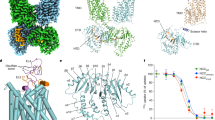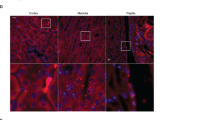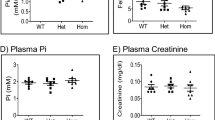Abstract
Urate, a naturally occurring product of purine metabolism, is a scavenger of biological oxidants implicated in numerous disease processes1,2,3, as demonstrated by its capacity of neuroprotection4,5. It is present at higher levels in human blood (200–500 µM) than in other mammals6, because humans have an effective renal urate reabsorption system, despite their evolutionary loss of hepatic uricase by mutational silencing6,7,8. The molecular basis for urate handling in the human kidney remains unclear because of difficulties in understanding diverse urate transport systems and species differences6,9,10. Here we identify the long-hypothesized9,10,11 urate transporter in the human kidney (URAT1, encoded by SLC22A12), a urate–anion exchanger regulating blood urate levels and targeted by uricosuric and antiuricosuric agents (which affect excretion of uric acid). Moreover, we provide evidence that patients with idiopathic renal hypouricaemia (lack of blood uric acid) have defects in SLC22A12. Identification of URAT1 should provide insights into the nature of urate homeostasis, as well as lead to the development of better agents against hyperuricaemia, a disadvantage concomitant with human evolution.
This is a preview of subscription content, access via your institution
Access options
Subscribe to this journal
Receive 51 print issues and online access
$199.00 per year
only $3.90 per issue
Buy this article
- Purchase on Springer Link
- Instant access to full article PDF
Prices may be subject to local taxes which are calculated during checkout




Similar content being viewed by others
References
Halliwell, B. in Handbook of Antioxidants (eds Cadenas, E. & Packer, L.) 243–255 (Dekker, New York, 1996)
Ames, B. N., Cathcart, R., Schwiers, E. & Hochstein, P. Uric acid provides an antioxidant defence in humans against oxidant- and radical-caused aging and cancer: A hypothesis. Proc. Natl Acad. Sci. USA 78, 6858–6862 (1981)
Becker, B. F. Towards the physiological function of uric acid. Free Radical Biol. Med. 14, 615–631 (1993)
Hooper, D. C. et al. Uric acid, a natural scavenger of peroxynitrite, in experimental allergic encephalomyelitis and multiple sclerosis. Proc. Natl Acad. Sci. USA 95, 675–680 (1998)
Keller, J. N. et al. Mitochondrial manganese superoxide dismutase prevents neural apoptosis and reduces ischemic brain injury: suppression of peroxynitrite production, lipid peroxidation, and mitochondrial dysfunction. J. Neurosci. 18, 687–697 (1998)
Abramson, R. G. & Lipkowitz, M. S. in Basic Principles in Transport, Comparative Physiology Vol. 3 (ed. Kinne, R. K. H.) 115–153 (Karger, Basel, 1990)
Wu, X., Lee, C. C., Muzny, D. M. & Caskey, C. T. Urate oxidase: Primary structure and evolutionary implications. Proc. Natl Acad. Sci. USA 86, 9412–9416 (1989)
Wu, X., Muzny, D. M., Lee, C. C. & Caskey, C. T. Two independent mutational events in the loss of urate oxidase. J. Mol. Evol. 34, 78–84 (1992)
Maesaka, J. K. & Fishbane, S. Regulation of renal urate excretion: A critical review. Am. J. Kidney Dis. 32, 917–933 (1998)
Sica, D. A. & Schoolwerth, A. C. in The Kidney, 6th edn (ed. Brenner, B. M.) 680–700 (Saunders, Philadelphia, 2000)
Berlinger, R. W., Hilton, J. G., Yü, T. F. & Kennedy, T. J. Jr The renal mechanism for urate excretion in man. J. Clin. Invest. 29, 396–401 (1950)
Sekine, T., Watanabe, N., Hosoyamada, M., Kanai, Y. & Endou, H. Expression cloning and characterization of a novel multispecific organic anion transporter. J. Biol. Chem. 272, 18526–18529 (1997)
Sweet, D. H., Wolff, N. A. & Pritchard, J. B. Expression cloning and characterization of ROAT1. The basolateral organic anion transporter in rat kidney. J. Biol. Chem. 272, 30088–30095 (1997)
Cha, S. H. et al. Molecular cloning and characterization of multispecific organic anion transporter 4 expressed in the placenta. J. Biol. Chem. 275, 4507–4512 (2000)
International Human Genome Sequencing Consortium. Initial sequencing and analysis of the human genome. Nature 409, 860–921 (2001)
Gründemann, D., Gorboulev, V., Gambaryan, S., Veyhl, M. & Koepsell, H. Drug excretion mediated by a new prototype of polyspecific transporter. Nature 372, 549–552 (1994)
Koepsell, H. Organic cation transporters in intestine, kidney, liver, and brain. Annu. Rev. Physiol. 60, 243–246 (1998)
Roch-Ramel, F., Werner, D. & Guisan, B. Urate transport in brush-border membrane of human kidney. Am. J. Physiol. 266, F797–F805 (1994)
Guggino, S. E., Martin, G. J. & Aronson, P. S. Specificity and modes of the anion exchanger in dog renal microvillus membranes. Am. J. Physiol. 244, F612–F621 (1983)
Kahn, A. M., Branham, S. & Weinman, E. J. Mechanism of urate and p-aminohippurate transport in rat renal microvillus membrane vesicles. Am. J. Physiol. 245, F151–F158 (1983)
Emmerson, B. T. The management of gout. N. Engl. J. Med. 334, 445–451 (1996)
Cullem, J. H., LeVine, M. & Fiore, J. M. Studies on hyperuricemia produced by pyrazinamide. Am. J. Med. 23, 587–595 (1957)
Roch-Ramel, F., Guisan, B. & Schild, L. Indirect coupling of urate and p-aminohippurate transport to sodium in human brush-border membrane vesicles. Am. J. Physiol. 270, F61–F68 (1996)
Mandel, L. J. Metabolic substrates, cellular energy production, and the regulation of proximal tubular transport. Annu. Rev. Physiol. 47, 85–101 (1985)
Kikuchi, Y. et al. Patients with renal hypouricemia with exercise-induced acute renal failure and chronic renal dysfunction. Clin. Nephrol. 53, 467–472 (2000)
Igarashi, T., Sekine, T., Sugimura, H., Hayakawa, H. & Arayama, T. Acute renal failure after exercise in a child with renal hypouricemia. Pediatr. Nephrol. 7, 292–293 (1993)
Halabe, A. & Sperling, O. Uric acid nephrolithiasis. Miner. Electrol. Metab. 20, 424–431 (1994)
Lipkowitz, M. S. et al. Functional reconstitution, membrane targeting, genomic structure, and chromosomal localization of a human urate transporter. J. Clin. Invest. 107, 1103–1115 (2001)
Johnson, R. J., Kivlighn, S. D., Kim, Y. G., Suga, S. & Fogo, A. B. Reappraisal of the pathogenesis and consequences of hyperuricemia in hypertension, cardiovascular disease, and renal disease. Am. J. Kidney Dis. 33, 225–234 (1999)
Cutler, R. G. Antioxidants and aging. Am. J. Clin. Nutr. 53, 373S–379S (1991)
Acknowledgements
We thank the patients for contributing to this study; Y. Terado for discussions on immunohistochemistry, K. Tachampa and J. Y. Kim for help in characterization of URAT1; A. Toki, M. Takahashi and M. Ikeda for technical assistance; and Merck Research Laboratories for providing losartan and EXP-3174. The anti-URAT1 polyclonal antibody was supplied by Trans Genic Inc. (formerly Kumamoto Immunochemical Laboratory). This work was supported in part by grants from the Japanese Ministry of Education, Science, Sports, Culture and Technology, Grants-in-Aid for Scientific Research, and High-Tech Research Center, the Science Research Promotion Fund of the Japan Private School Promotion Foundation.
Author information
Authors and Affiliations
Corresponding author
Ethics declarations
Competing interests
The authors declare that they have no competing financial interests
Rights and permissions
About this article
Cite this article
Enomoto, A., Kimura, H., Chairoungdua, A. et al. Molecular identification of a renal urate–anion exchanger that regulates blood urate levels. Nature 417, 447–452 (2002). https://doi.org/10.1038/nature742
Received:
Accepted:
Published:
Issue Date:
DOI: https://doi.org/10.1038/nature742
This article is cited by
-
Progress in the clinical effects and adverse reactions of ticagrelor
Thrombosis Journal (2024)
-
Identification of three distinct cell populations for urate excretion in human kidneys
The Journal of Physiological Sciences (2024)
-
Genotype and Phenotype of Renal Hypouricemia: A Single-Center Study from China
Molecular Diagnosis & Therapy (2024)
-
Hyperuricemia: An Intriguing Connection to Metabolic Syndrome, Diabetes, Kidney Disease, and Hypertension
Current Hypertension Reports (2024)
-
Hyperuricemia exacerbates abdominal aortic aneurysm formation through the URAT1/ERK/MMP-9 signaling pathway
BMC Cardiovascular Disorders (2023)
Comments
By submitting a comment you agree to abide by our Terms and Community Guidelines. If you find something abusive or that does not comply with our terms or guidelines please flag it as inappropriate.



